Abstract
Cisapride is a synthetic drug which binds, in vitro, to type 2 serotonin receptors. We examined the influence of serotonin and cisapride on ion transport across intestinal mucosa in vitro and studied the effect of cisapride on the response to serotonin. Segments of ileum of male Sprague-Dawley rats were stripped of muscle layers and mounted in flux chambers. The addition of serotonin (10(-8) to 10(-4) M) to the serosal aspect of the mucosa caused a rapid, dose-dependent rise in short circuit current and transmural potential difference. Cisapride alone (5 X 10(-5) M), when added to the mucosal and serosal surfaces, had no effect on the short circuit current, transmural potential difference, resistance, or sodium and chloride fluxes across the mucosa. It did, however, inhibit the response of the mucosa to serotonin (10(-5) M) in a dose dependent manner and blocked it completely at a concentration of 5 X 10(-5) M. Serotonin (5 X 10(-5) M) increased serosal to mucosal flux of chloride from 12.6 +/- 0.8 to 15.2 +/- 0.6 mumol/cm2/h (p less than 0.025), thus reducing net chloride absorption from 4.65 +/- 0.81 to 1.49 +/- 1.04 mumol/cm2/h (p less than 0.05). This effect was completely blocked by cisapride (5 X 10(-5) M). In summary, cisapride inhibits the effect of serotonin on rat ileal ion transport, probably by blocking type 2 serotonin receptors.
Full text
PDF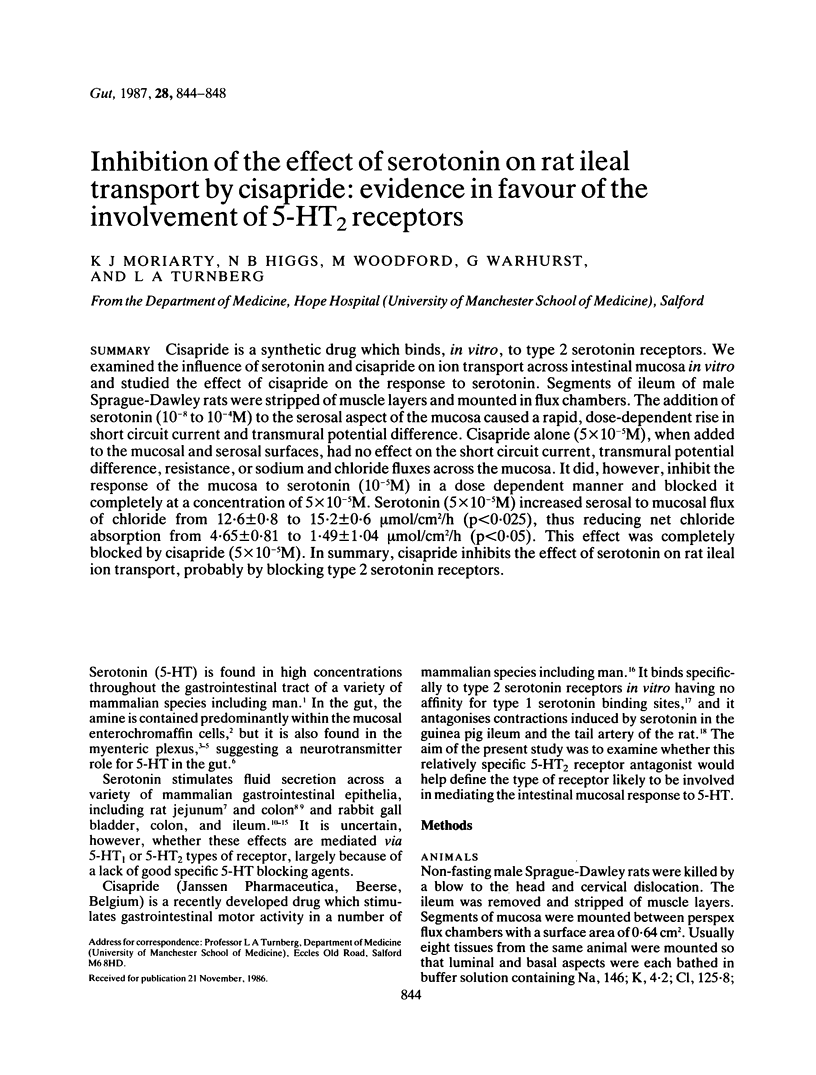
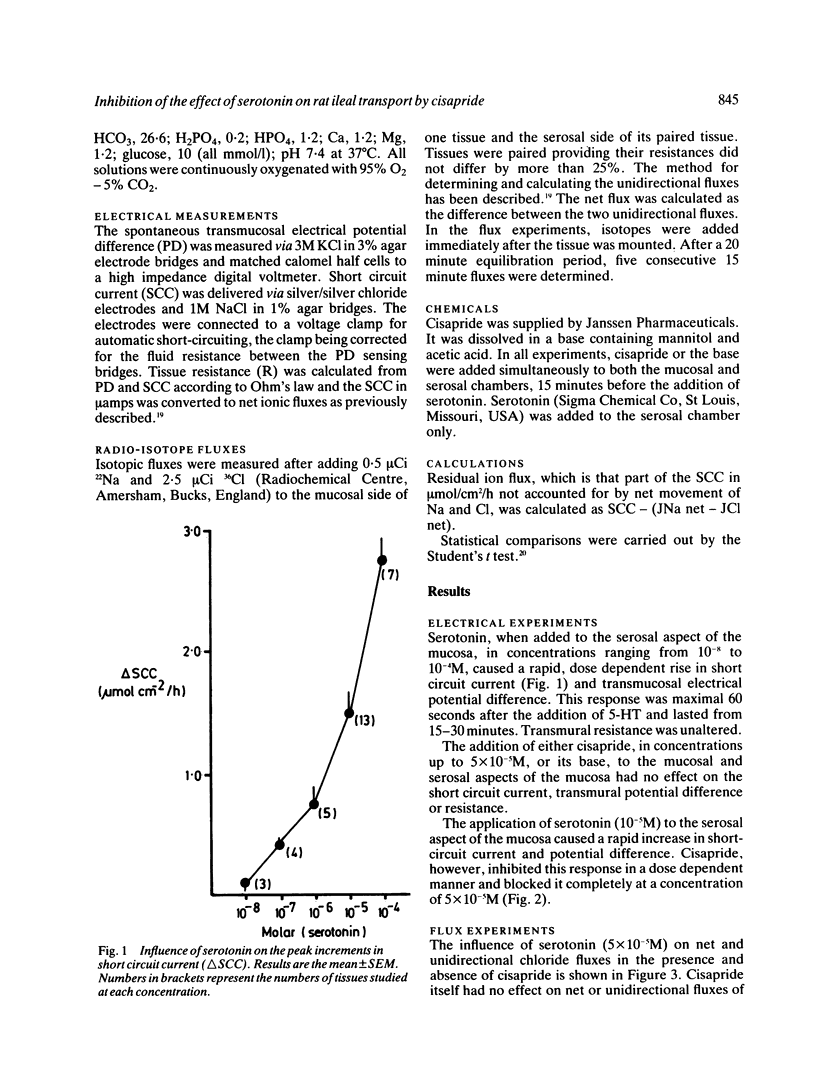
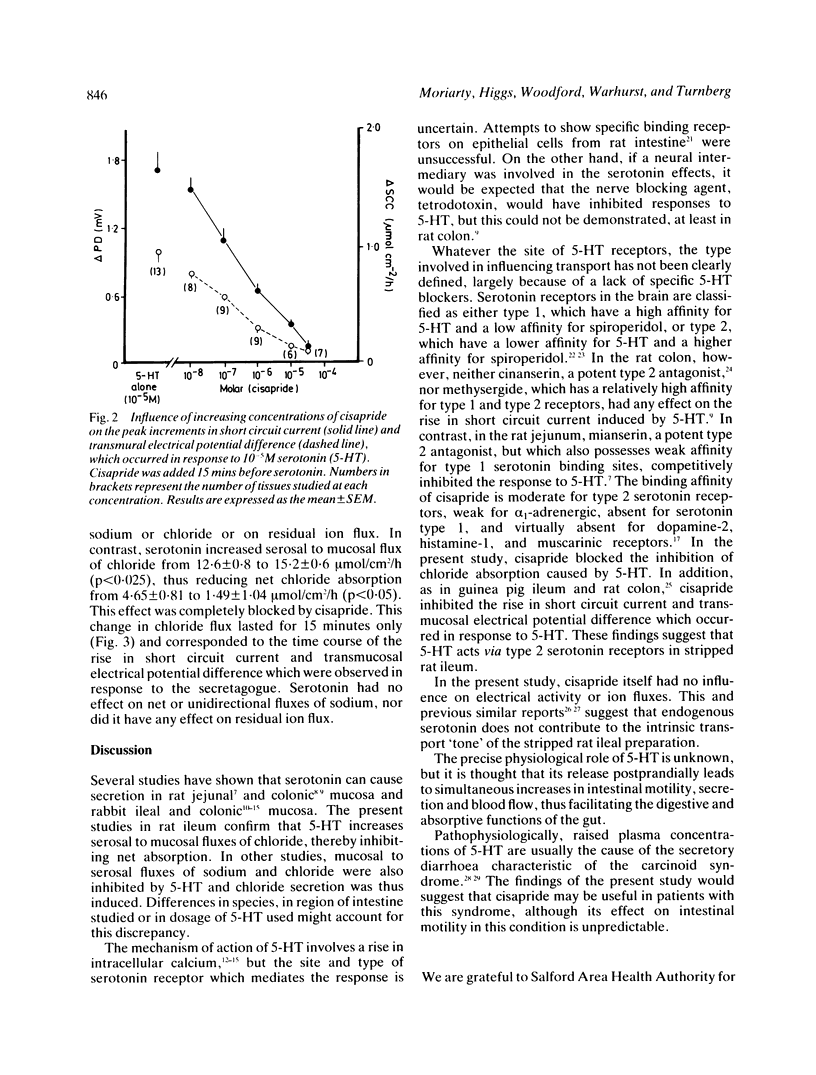
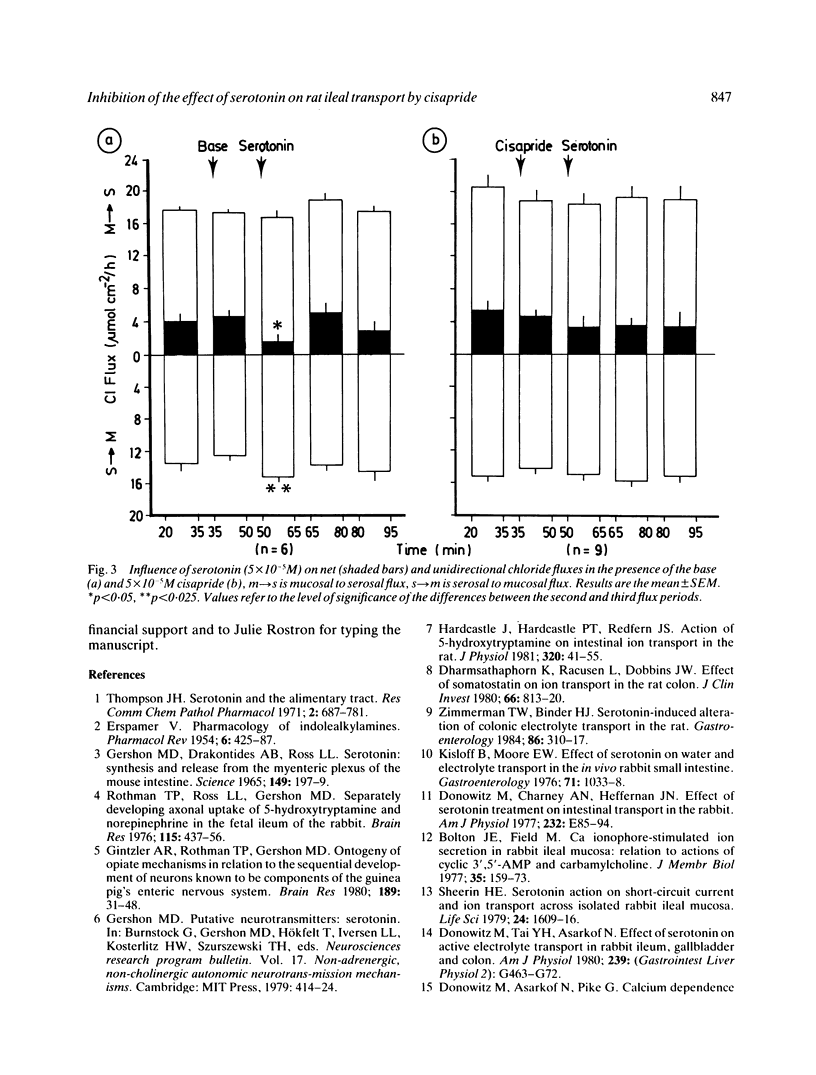
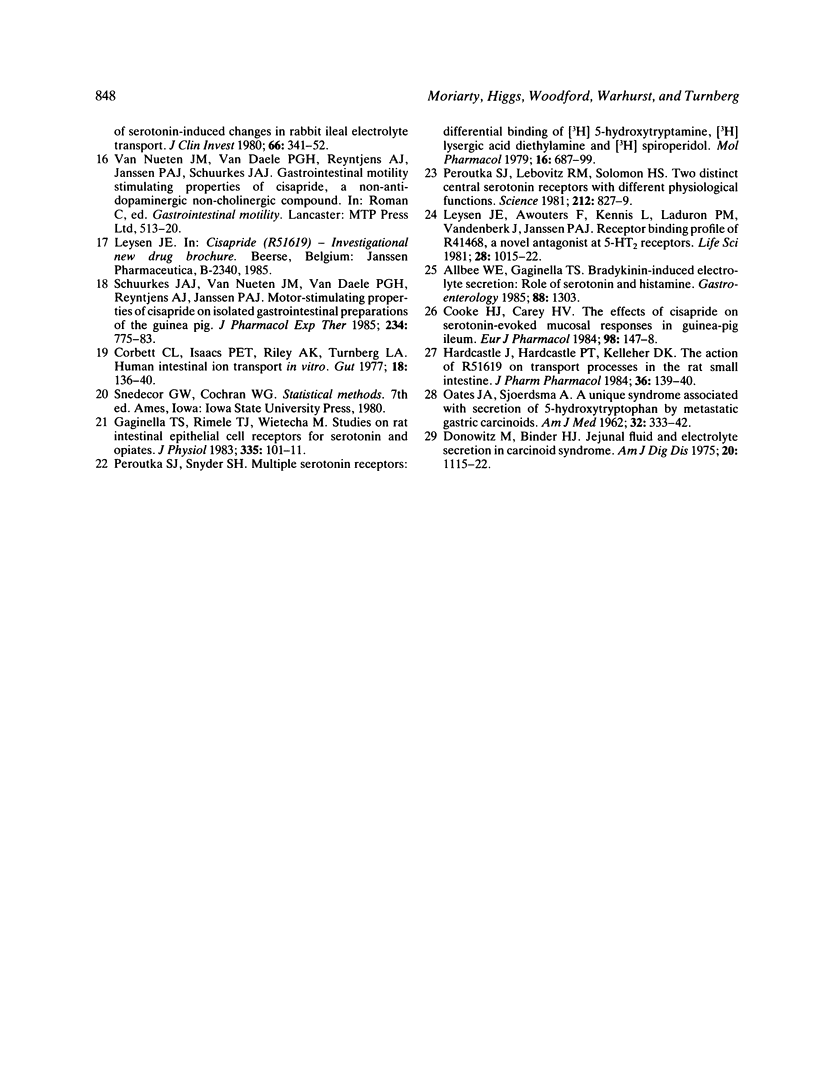
Selected References
These references are in PubMed. This may not be the complete list of references from this article.
- Bolton J. E., Field M. Ca ionophore-stimulated ion secretion in rabbit ileal mucosa: relation to actions of cyclic 3',5'-AMP and carbamylcholine. J Membr Biol. 1977 Jun 30;35(2):159–173. doi: 10.1007/BF01869947. [DOI] [PubMed] [Google Scholar]
- Cooke H. J., Carey H. V. The effects of cisapride on serotonin-evoked mucosal responses in guinea-pig ileum. Eur J Pharmacol. 1984 Feb 10;98(1):147–148. doi: 10.1016/0014-2999(84)90123-7. [DOI] [PubMed] [Google Scholar]
- Corbett C. L., Isaacs P. E., Riley A. K., Turnberg L. A. Human intestinal ion transport in vitro. Gut. 1977 Feb;18(2):136–140. doi: 10.1136/gut.18.2.136. [DOI] [PMC free article] [PubMed] [Google Scholar]
- Dharmsathaphorn K., Racusen L., Dobbins J. W. Effect of somatostatin on ion transport in the rat colon. J Clin Invest. 1980 Oct;66(4):813–820. doi: 10.1172/JCI109919. [DOI] [PMC free article] [PubMed] [Google Scholar]
- Donowitz M., Asarkof N., Pike G. Calcium dependence of serotonin-induced changes in rabbit ileal electrolyte transport. J Clin Invest. 1980 Aug;66(2):341–352. doi: 10.1172/JCI109862. [DOI] [PMC free article] [PubMed] [Google Scholar]
- Donowitz M., Binder H. J. Jejunal fluid and electrolyte secretion in carcinoid syndrome. Am J Dig Dis. 1975 Dec;20(12):1115–1122. doi: 10.1007/BF01070754. [DOI] [PubMed] [Google Scholar]
- Donowitz M., Charney A. N., Heffernan J. M. Effect of serotonin treatment on intestinal transport in the rabbit. Am J Physiol. 1977 Jan;232(1):E85–E94. doi: 10.1152/ajpendo.1977.232.1.E85. [DOI] [PubMed] [Google Scholar]
- Donowitz M., Tai Y. H., Asarkof N. Effect of serotonin on active electrolyte transport in rabbit ileum, gallbladder, and colon. Am J Physiol. 1980 Dec;239(6):G463–G472. doi: 10.1152/ajpgi.1980.239.6.G463. [DOI] [PubMed] [Google Scholar]
- ERSPAMER V. Pharmacology of indole-alkylamines. Pharmacol Rev. 1954 Dec;6(4):425–487. [PubMed] [Google Scholar]
- GERSHON M. D., DRAKONTIDES A. B., ROSS L. L. SEROTONIN: SYNTHESIS AND RELEASE FROM THE MYENTERIC PLEXUS OF THE MOUSE INTESTINE. Science. 1965 Jul 9;149(3680):197–199. doi: 10.1126/science.149.3680.197. [DOI] [PubMed] [Google Scholar]
- Gaginella T. S., Rimele T. J., Wietecha M. Studies on rat intestinal epithelial cell receptors for serotonin and opiates. J Physiol. 1983 Feb;335:101–111. doi: 10.1113/jphysiol.1983.sp014522. [DOI] [PMC free article] [PubMed] [Google Scholar]
- Gintzler A. R., Rothman T. P., Gershon M. D. Ontogeny of opiate mechanisms in relation to the sequential development of neurons known to be components of the guinea pig's enteric nervous system. Brain Res. 1980 May 5;189(1):31–48. doi: 10.1016/0006-8993(80)90005-0. [DOI] [PubMed] [Google Scholar]
- Hardcastle J., Hardcastle P. T., Kelleher D. K. The action of R51619 on transport processes in the rat small intestine. J Pharm Pharmacol. 1984 Feb;36(2):139–140. doi: 10.1111/j.2042-7158.1984.tb03016.x. [DOI] [PubMed] [Google Scholar]
- Hardcastle J., Hardcastle P. T., Redfern J. S. Action of 5-hydroxytryptamine on intestinal ion transport in the rat. J Physiol. 1981 Nov;320:41–55. doi: 10.1113/jphysiol.1981.sp013933. [DOI] [PMC free article] [PubMed] [Google Scholar]
- Kisloff B., Moore E. W. Effect of serotonin on water and electrolyte transport in the in vivo rabbit small intestine. Gastroenterology. 1976 Dec;71(6):1033–1038. [PubMed] [Google Scholar]
- Leysen J. E., Awouters F., Kennis L., Laduron P. M., Vandenberk J., Janssen P. A. Receptor binding profile of R 41 468, a novel antagonist at 5-HT2 receptors. Life Sci. 1981 Mar 2;28(9):1015–1022. doi: 10.1016/0024-3205(81)90747-5. [DOI] [PubMed] [Google Scholar]
- OATES J. A., SJOERDSMA A. A unique syndrome associated with secretion of 5-hydroxytryptophan by metastatic gastric carcinoids. Am J Med. 1962 Mar;32:333–342. doi: 10.1016/0002-9343(62)90124-9. [DOI] [PubMed] [Google Scholar]
- Peroutka S. J., Lebovitz R. M., Snyder S. H. Two distinct central serotonin receptors with different physiological functions. Science. 1981 May 15;212(4496):827–829. doi: 10.1126/science.7221567. [DOI] [PubMed] [Google Scholar]
- Peroutka S. J., Snyder S. H. Multiple serotonin receptors: differential binding of [3H]5-hydroxytryptamine, [3H]lysergic acid diethylamide and [3H]spiroperidol. Mol Pharmacol. 1979 Nov;16(3):687–699. [PubMed] [Google Scholar]
- Rothman T. P., Ross L. L., Gershon M. D. Separately developing axonal uptake of 5-hydroxytryptamine and norepinephrine in the fetal ileum of the rabbit. Brain Res. 1976 Oct 22;115(3):437–456. doi: 10.1016/0006-8993(76)90360-7. [DOI] [PubMed] [Google Scholar]
- Schuurkes J. A., Van Nueten J. M., Van Daele P. G., Reyntjens A. J., Janssen P. A. Motor-stimulating properties of cisapride on isolated gastrointestinal preparations of the guinea pig. J Pharmacol Exp Ther. 1985 Sep;234(3):775–783. [PubMed] [Google Scholar]
- Sheerin H. E. Serotonin action on short-circuit current and ion transport across isolated rabbit ileal mucosa. Life Sci. 1979 Apr 23;24(17):1609–1615. doi: 10.1016/0024-3205(79)90023-7. [DOI] [PubMed] [Google Scholar]
- Thompson J. H. Serotonin and the alimentary tract. Res Commun Chem Pathol Pharmacol. 1971 Jul-Sep;2(4):687–781. [PubMed] [Google Scholar]
- Zimmerman T. W., Binder H. J. Serotonin-induced alteration of colonic electrolyte transport in the rat. Gastroenterology. 1984 Feb;86(2):310–317. [PubMed] [Google Scholar]


